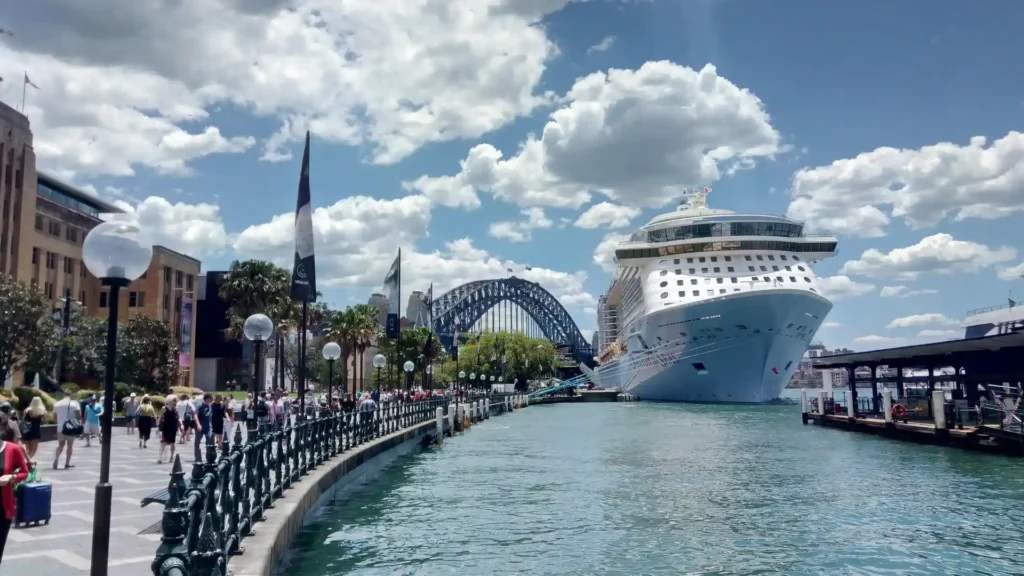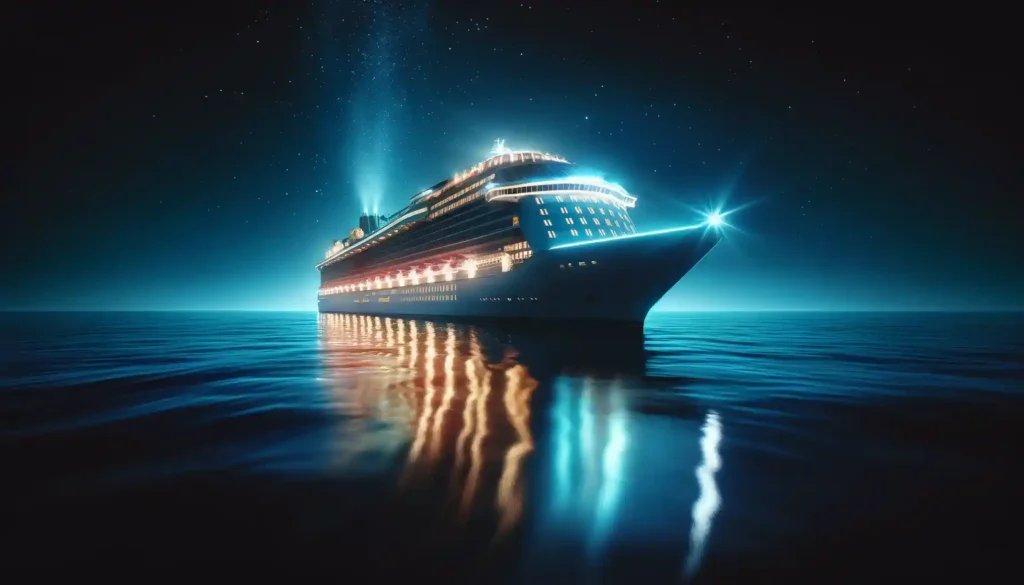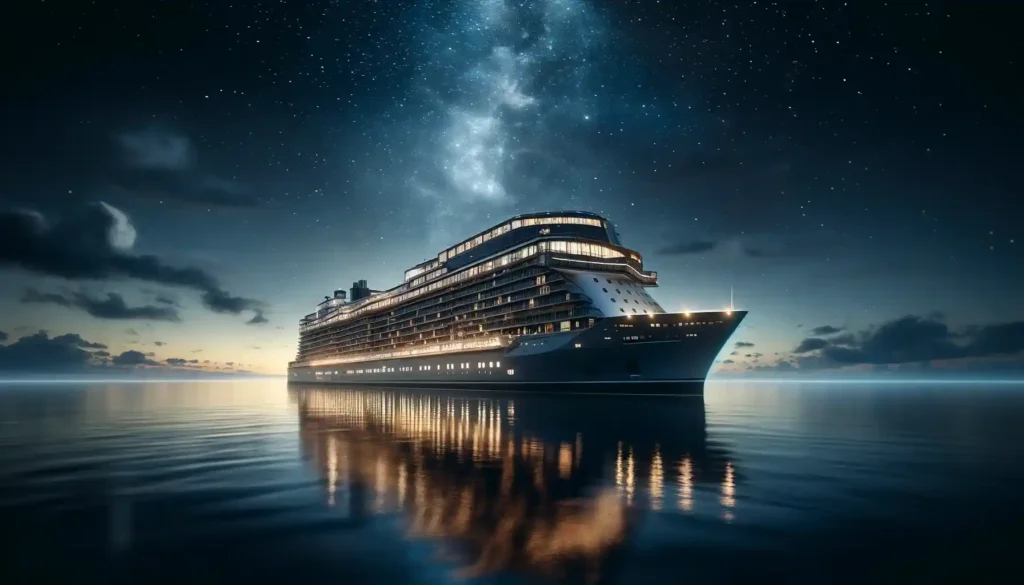Cruise ships are floating cities, providing all the amenities one would expect from a luxurious vacation resort. However, the operation of these massive vessels requires significant energy. Understanding the power consumption and fuel usage of modern cruise ships offers insight into the engineering marvels that they are and the challenges the industry faces in terms of energy efficiency and environmental impact.

How Much Power Does a Cruise Ship Consume?
Mega Watt Consumption
The power consumption of a cruise ship depends largely on its size and the services offered. A large cruise ship, like those from the Royal Caribbean or Carnival fleets, can consume up to 80 megawatts of power during peak operation times—equivalent to the power usage of a small town.

This immense power is necessary to support air conditioning, lighting, water desalination plants, kitchens, elevators, and other critical operations that make the cruise experience what it is today.
Breakdown of Power Usage
- Propulsion: About 50-60% of the total energy produced is used for propulsion to keep the ship sailing smoothly at its cruising speed.
- Hotel Operations: The remaining 40-50% powers onboard amenities such as lighting, heating, air conditioning, and appliances.
Fuel Consumption on Cruise Ships

Types of Fuel Used
Cruise ships primarily use Marine Gas Oil (MGO) or Heavy Fuel Oil (HFO), also known as bunker fuel. The choice of fuel depends on the ship’s engine design and the environmental regulations affecting the route. Newer ships are increasingly being equipped to use Liquefied Natural Gas (LNG), which burns cleaner than other fossil fuels.
Average Fuel Usage
On average, a large cruise ship will consume about 140 to 150 tons of fuel per day, which equates to around 30 to 50 gallons per mile traveled. Fuel consumption can vary based on the ship’s speed, load, and weather conditions.
Environmental Impact
The significant fuel consumption of cruise ships has a considerable environmental impact, primarily in terms of carbon emissions. A cruise ship can emit as much CO2 as thousands of cars combined. The sulfur content of the bunker fuel also contributes to the emission of sulfur oxides, harmful pollutants that can cause respiratory problems and contribute to acid rain.
Industry Responses and Innovations
In response to growing environmental concerns, the cruise industry has begun adopting more sustainable practices and technologies. Some of these include:
- Advanced Wastewater Treatment Systems: To reduce pollution from sewage.
- Shore Power Hookups: Allowing ships to shut down their engines and connect to local power grids while docked.
- Scrubber Systems: To remove harmful pollutants from exhaust gases.
- Energy Efficiency Measures: Like LED lighting, better hull designs, and heat recovery systems.
The Future: Towards Sustainability
Looking ahead, the industry is exploring more radical solutions such as fully electric cruise ships for shorter routes and hybrid systems that use solar and wind energy as supplementary power sources. These developments are crucial as the industry aims to reduce its carbon footprint and align with global sustainability goals.
Cruising Power: Unleashing the Power of Luxury Cruises

Luxury cruising represents the pinnacle of oceanic adventure, combining elegance with the thrill of exploration. In “Cruising Power: Unleashing the Power of Luxury Cruises,” we delve into the transformative experience of high-end cruising, offering insights into what makes this travel style a powerhouse in the tourism industry. This article is your guide to understanding the luxurious amenities, unique itineraries, and superior service that define luxury cruising.
What Defines a Luxury Cruise?
Luxury cruises stand out from standard voyages primarily due to their emphasis on excellence and exclusivity. These cruises are characterized by:
- Smaller Ships: Providing a more intimate experience and access to less-commercial ports.
- All-Inclusive Offers: High-end cruises often include all amenities, such as fine dining, beverages, and excursions, in the ticket price.
- Exceptional Service: Staff-to-guest ratios are high, ensuring personalized service.
- Exquisite Cuisine: Meals are crafted by renowned chefs and often feature local ingredients from port destinations.
- Spacious Accommodations: Suites are typically larger, with luxurious furnishings and private balconies.
- Unique Itineraries: Destinations are exotic, less crowded, and often unreachable by larger ships.
The Benefits of Luxury Cruising

Luxury cruising offers numerous advantages that go beyond mere travel, including:
Unparalleled Comfort and Relaxation
Luxury cruises provide a sanctuary on the sea. From high-thread-count linens to in-suite spa services, every aspect is designed for comfort.
Personalized Experiences
Whether it’s a butler service or custom excursion planning, luxury cruises cater to individual preferences, making each journey unique.
Culinary Excellence
Dining on a luxury cruise is a highlight, with gourmet dishes and fine wines served in various onboard restaurants.
Educational Opportunities
Many luxury cruises offer lectures and workshops with experts in fields like history, marine biology, and culinary arts, enhancing the travel experience.
Top Luxury Cruise Lines
To experience the epitome of cruising power, consider booking with one of the top luxury cruise lines:
- Silversea Cruises: Known for its exotic destinations and intimate ships.
- Regent Seven Seas Cruises: Offers one of the most inclusive luxury cruising experiences.
- Crystal Cruises: Famous for its refined elegance and sophisticated programming.
- Seabourn Cruise Line: Delivers a close-knit community feel with ultra-luxury amenities.
Planning Your Luxury Cruise
When planning a luxury cruise, consider the following tips to maximize your experience:
- Book Early: Luxury cruises often sell out quickly due to their limited size.
- Use a Travel Advisor: Specialized travel agents can provide insights and manage logistics, enhancing your cruise experience.
- Check for Packages: Look for airfare-included deals or pre-and-post cruise hotel stays.
- Review Port Itineraries: Choose a cruise that offers the destinations and excursions that match your interests.

Seas the Day: The Force Behind Effective Cruising Conclusion
Luxury cruising is more than just a journey; it’s a power-packed experience that offers the pinnacle of travel excellence. By choosing a luxury cruise, you embark on a voyage that promises not only relaxation and pampering but also an enriching exploration that can rejuvenate mind and body alike. With meticulous attention to detail, unparalleled service, and exclusive itineraries, luxury cruises continue to redefine the very essence of travel. Whether you’re celebrating a special occasion or simply seeking the ultimate escape, luxury cruising offers a powerful way to satisfy your wanderlust with style and sophistication.
As you consider your options for an unforgettable maritime adventure, remember that the power of luxury cruising lies in its ability to blend the comforts of the finest resorts with the excitement of discovering the world’s most secluded gems.
High Seas Strategy Conclusion: The Power of Cruising
The power and fuel consumption of modern cruise ships underlines the scale of their operations and the challenges of balancing luxury travel with environmental responsibility. As technology advances, the cruise industry is poised to become more energy-efficient and less reliant on fossil fuels. This shift is not only necessary for environmental sustainability but also for ensuring the long-term viability of cruising as a popular mode of travel.
